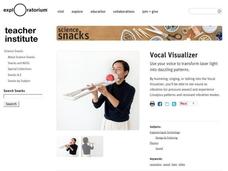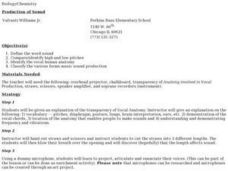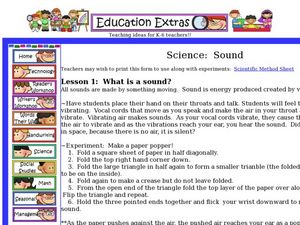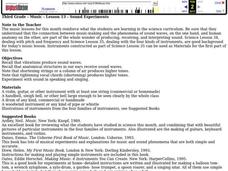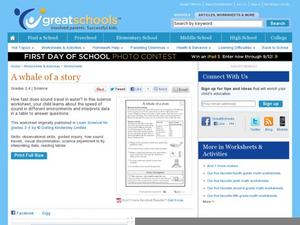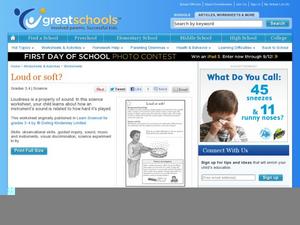Exploratorium
Vocal Visualizer
Make sound visible with an activity that provides directions for how to build a vocal visualizer meant to create light patterns. Making noise into the visualizer causes a mirror to vibrate, reflecting a laser beam, and creating the...
Curated OER
Finding Your Big Voice
Young scholars use their diaphragm to create vocal vibrations, vocal sounds, and project sounds through an open space. In this sounds lesson plan, students learn how to use their voices to project through an auditorium.
Curated OER
Vibrations
Students explore how vibrations create sound by strumming a rubber band. They feel the vibration of their own vocal chords. Then they explore the motion of sound waves and echoes. They rely on their own hearing to locate others in their...
Curated OER
Vocal Exploration
Students explore vocal anatomy. In this biology/music lesson, students first learn vocabulary associated with the voice and body. They then use straws, microphones and recorders to differentiate between high and low pitches and...
Curated OER
Sound and Frequency
Pupils pose their hypothesis, they ready their instruments, then record their observations. This is the science of sound lesson. They move through 5 stations, each focused on a different element of aspect of sound. Check this lesson out,...
Curated OER
What is a Sound?
Second graders explore the concept of sound. For this sound lesson, 2nd graders discover what sound, vibrations, and pitch are through several experiments. Students watch a Power Point presentation that allows them to complete a graphic...
Curated OER
Sound and Hearing
In this sounds worksheet, students will review how sound is created by vibrations. Students will understand what creates vibrations and how the ear receives those sound waves. This worksheet has 10 fill in the blank, 9 multiple choice, 1...
Curated OER
What is Sound?
Second graders discuss sound and describe them. For this investigative lesson students observe sound through their eyes, bodies and ears.
Acoustical Society of America
Musical Instruments
Mix it up and engage learners in a lesson on music and physical science. Using cups, strings, guitars, and voice, the class will experiment with sound vibration and frequency. They'll use each instrument and fill out a worksheet that...
Curated OER
Producing Sounds
Third graders examine items that make sounds. When given craft sticks, 3rd graders practice making different sounds with them. Sticks are rubbed together or placed partially on a desk and plucked. Afterward, students discuss the types of...
Curated OER
Music
Third graders study sound waves and vibrations. They sing a silly round in three parts.
Curated OER
Singing II
In this music worksheet, 4th graders study terminology associated with vocal music. Students are then asked to complete five multiple choice questions and provided with one extra credit option.
Curated OER
Noise Underwater
Sixth graders predict with reasoning how a sound will be heard underwater and record and communicate their findings. They listen to the difference in the way noise sounds underwater verses out of water and relate this to how whales and...
Curated OER
Phonetics: The Study of Speech Sounds
A beginning study of linguistics will include phonetics and the way sound is made. Show your class these great slides with pictures and examples of consonants, vowels, and blends. Placement of the tongue, lips, etc. are displayed to give...
Curated OER
A Whale of a Story
Does sound travel faster in water or in the air? Put the question to the test with a science experiment. After reviewing a table of data, third and fourth graders decide which statements are true and which ones are false. The bottom of...
Curated OER
Loud or soft?
Send this cute activity home with kids, to increase family involvement. They'll consider what would happen if rice was bounced in a tambourine, and then they'll complete a sound activity by makings an instrument out of wax paper and a...
Curated OER
The Phenomenon of Sound: Waves
Students explore sound waves. In this sound waves activity, students brainstorm different sounds and how sounds move or travel. Students then create a KWL chart and work through six different lab activities to examine how sound waves...
Curated OER
Sound for Sight
Young scholars study echolocation and understand how dolphins use it to locate prey, escape predators, and navigate their environment. They view a video, "In the Wild-Dolphins with Robin Williams" and see first hand how dolphins...
Curated OER
Radical Reeds
In this reed instrument learning exercise, students make a clarinet from a straw and use scissors. Students answer 2 questions about testing their clarinet.
Curated OER
The Invention of the Telephone
Students study the history of the telephone and its inventor. In this communications lesson students complete a tuning fork experiment to further demonstrate how sound is produced.
Curated OER
Bird Banter
Pupils listen to examples of common bird songs of birds found in Illinois. As a class, they discover the importance between the differences in songs and calls. They practice making their own bird calls and songs to end the lesson.
Curated OER
Reading Food Labels
Students investigate the concept of phonemic awareness in order to help increase reading comprehension. The reading of food labels creates the context for the practice session. They pay particular attention to certain sounds that must be...


